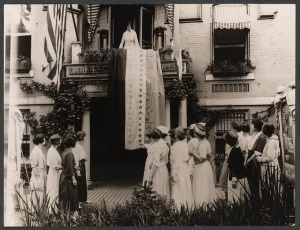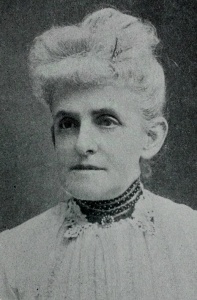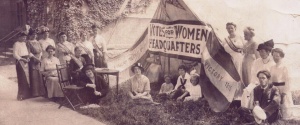Helping Women Win the Vote in Albany & Washington

By Traci I. Langworthy
August 26, 2020 will mark the centennial anniversary of the official ratification of the 19th Amendment to the U.S. Constitution granting women the right to vote. As the decades have passed, our national memory of the suffrage movement has galvanized around this final, crowning achievement. Often forgotten are the many years of protest and grassroots organizing that paved the way for national victory. Much of the work went on at the local level, as suffrage leaders canvassed election district by election district to help turn the tide of public opinion and convince elected officials to support the cause. Women’s enfranchisement, after all, depended upon men’s votes to change the law.
New York State holds a particularly esteemed place in the long-term struggle. In the mid-1850s, a core group of New York State reformers – including Elizabeth Cady Stanton, Ernestine Rose, and other women as well as men – began to “systematize” their efforts toward women’s equality. In 1854, Susan B. Anthony, whose work on behalf of temperance and the abolition of slavery had only recently led her to women’s rights activism, began traveling the state as “general agent” of the Woman’s Rights New York State Committee. She organized “conventions” in each of the counties where she and other key supporters spoke and distributed petitions.[1] It was a simple model for grassroots advocacy that suffragists would use again and again in years to come.

The first stop in Anthony’s 1854-1855 travels was Chautauqua County. On the day after Christmas in 1854, she presided over a convention at the Chautauqua County Courthouse in Mayville, New York to discuss “all the reasons which impel Woman to demand her right of Suffrage.”[2] She went on to lead a multitude of similar public meetings across the state for the remainder of the decade. Her efforts paid off, in part. In 1860, the New York State Legislature passed a law expanding married women’s rights to control their own property and wages and attain custody of their children in the event of a divorce or separation. Albany lawmakers thus were among the first in the nation to grant women some equal protections before the law. But New York women’s right to vote would have to wait until the next century.

As suffragists doubled their efforts in the years after the Civil War, the rural reaches of Southwestern New York State became strongholds for the cause. In fact, by the waning years of the nineteenth century, women’s suffrage drew some of its strongest support from farming towns where women made vital contributions to the sustenance of their households and communities. Many women from the Chautauqua-Allegany region joined what became known as “political equality clubs.” In addition to advocating for women’s suffrage, these local organizations taught women about civic institutions and parliamentary procedure, shared news of women’s issues around the nation and world, and promoted the election of women to local school boards. (Women in New York State earned the right to vote in school board elections in 1880.)
The first of these clubs was founded in 1887 by thirteen women in Jamestown, New York.[3] No other clubs of this name were known to exist at the time. (Although other local suffrage clubs were in existence elsewhere in the nation – including a “Women’s Political Club” founded in December 1885 in Rochester, New York – they only later adopted the moniker “political equality.”[4]) Before a year had passed, eleven more political equality clubs formed in the area, leading to the formation of the Chautauqua County Political Equality Club on October 31, 1888.[5] In another three years, the county group’s membership would well exceed one thousand individuals across twenty-four different townships, making it the largest county suffrage organization in the United States.[6]
The nation’s leading suffragists quickly took notice. At the annual convention of the National American Woman Suffrage Association in 1891, delegates designated New York as the “banner state” and Chautauqua as the “banner county” in the nation, based on the membership rolls of the Chautauqua County PEC. Chautauqua County held this distinction into the mid-1890s.[7] Throughout this period, Anthony, Rev. Anna Howard Shaw, Carrie Chapman Catt, and other noted suffrage lecturers regularly appeared at Lily Dale, New York, Chautauqua Institution, and county conventions.

In 1894, when state lawmakers were due to hold a special convention to update the state constitution (New York State law provides for such a convention every twenty years), women across the region worked tirelessly to gather signatures for a statewide petition campaign to show support for adding women’s suffrage to the list of revisions. Their efforts ultimately failed; delegates to the convention refused to bring women’s enfranchisement before the state’s voters in that year. Still, the numbers of signatures collected show both the strength of support for women’s suffrage in the state’s western counties and the effectiveness of small-town organizing. Although somewhat misleading since the petitions were signed by women (who could not vote) as well as men, the 12,547 signatures canvassed by club members in Chautauqua County were equivalent in number to about 90 percent of the county’s voter turnout in the preceding year’s election. A similarly remarkable level of support also resulted from petition campaigns in Allegany, Cattaraugus, and the other largely rural upstate counties of Orleans, Wyoming, and Yates. In Monroe County, suffragists in Rochester and surrounding towns actually collected enough signatures to exceed the number of men who voted in their county in 1893.[8]
When Albany lawmakers finally submitted the question of women’s suffrage to state voters in 1915, men in Chautauqua County approved the measure by the widest margin in the state.[9] Although it failed that year statewide, the editor of the Jamestown Evening Journal held that local women should be proud “in this showing for their own city and county.
It shows that they not only represented but helped to mould [sic] public sentiment on the suffrage question, and Chautauqua County will go down into history as a leader in the suffrage movement.”[10]
The persistent advocacy of women in Southwestern New York ultimately paved the way for New York State voters’ passage of a referendum on women’s suffrage in 1917. In that, upstate women might also claim a small role in the eventual passage of the 19th Amendment; when New York became the first eastern state to grant women the vote, the political balance in the U.S. Congress began to shift. The final events were now set in motion, after many years of committed activism on the part of many progressive-minded Americans.
Women’s Political Union tent headquarters, Dunkirk, NY, 1914. Photo courtesy Dunkirk, NY Historical Museum
For Further Reading
Elnora M. Babcock, “Political Equality Movement,” in The Centennial History of Chautauqua County, New York (Jamestown: Chautauqua History Company, 1904), 1: 510-519, https://archive.org/stream/centennialhistor01chau#page/510/mode/2up.
John P. Downs, ed., History of Chautauqua County, New York, and Its People (New York: American Historical Society, 1921), 1: 351-356, https://archive.org/stream/historyofchautau02downs.
References
[1] Elizabeth Cady Stanton, Susan B. Anthony, and Matilda Joslyn Gage, eds., History of Woman Suffrage, vol. 1, 1848-1861 (New York: Fowler and Wells, 1881), 619, https://archive.org/stream/historyofwomansu01stan. Anthony’s diary documents her travels in 1854 to 1855. See Ann D. Gordon, ed., In the School of Anti-Slavery, 1840 to 1866, vol. 1 of The Selected Papers of Elizabeth Cady Stanton and Susan B. Anthony (New Brunswick: Rutgers University Press, 1997), 288–289, 291-295, 301-302.
[2] “Woman’s Right to Suffrage,” Mayville Sentinel, December 20, 1854; “Chautauqua County Women’s Rights Convention,” Mayville Sentinel, January 3, 1855.
[3] “Political Equality Club,” Jamestown Evening Journal, Saturday, November 12, 1887, 4.
[4] For a summary of the Rochester Women’s Political Club, renamed the Rochester Political Equality Club, see Blake McKelvey, “Woman’s Rights in Rochester: A Century of Progress,” Rochester History 10, nos. 2–3 (July 1948): 15–17 (http://www.libraryweb.org/~rochhist/v10_1948/v10i2-3.pdf). Geneva, New York was the home of another particularly active PEC by the late 1890s, as seen in Robert A. Huff, “Anne Miller and the Geneva Political Equality Club, 1897–1912,” New York History 65, no. 4 (October 1984): 325–348.
[5] See Elnora Monroe Babcock, “Political Equality Movement,” in The Centennial History of Chautauqua County, New York (Jamestown: Chautauqua History Company, 1904), 1: 510-519; John P. Downs, ed., History of Chautauqua County, New York, and Its People (New York: American Historical Society, 1921), 1: 351-356; and Minutes of the Chautauqua County Political Equality Club, 1888–1903, Ms. 29, Special Collections, Fenton History Center Museum and Library, Jamestown, NY.
[6] See Babcock, “Political Equality Movement,” 515; and the report of then-state suffrage association president Jean Brooks Greenleaf in “The National American Woman Suffrage Convention,” The Business Woman’s Journal [later American Magazine] (February 1892): 53.
[7] “The National American Woman Suffrage Convention,” 53; “Woman’s Day at Cassadaga Lake,” The Woman’s Tribune, September 10, 1892, 172. Babcock reported that the county held this distinction for “several years” (The Centennial History of Chautauqua County, 1: 515). In her annual report of 1892, state President Jean Brooks Greenleaf confirmed that Chautauqua County had not “lowered her colors, though closely pressed by Cattaraugus and Wyoming counties in activity” (“New York,” The Woman’s Tribune, February 4, 1893, 30).
[8] 1894. Constitutional-Amendment Campaign Year: Report of the New York State Woman Suffrage Association (Rochester: Charles Mann, 1895), 139-141, https://books.google.com/books?id=gRs5AQAAMAAJ.
[9] Downs, History of Chautauqua County, 356; “Woman Suffrage Defeated in Three of the Eastern States,” Jamestown Evening Journal, November 3, 1915, 1.
[10] “Woman Suffrage,” Jamestown Evening Journal, November 3, 1915, 4.

